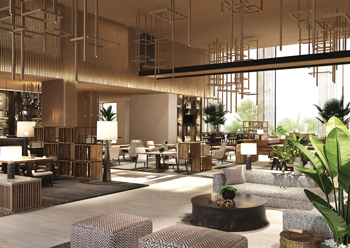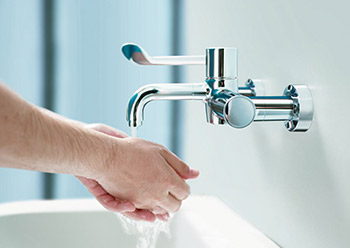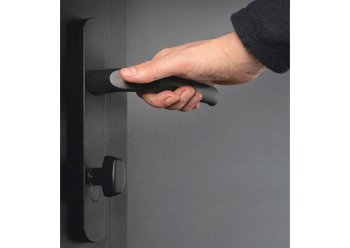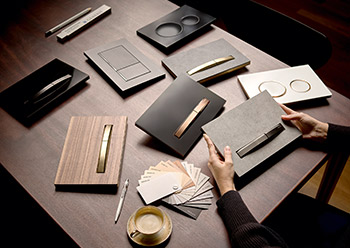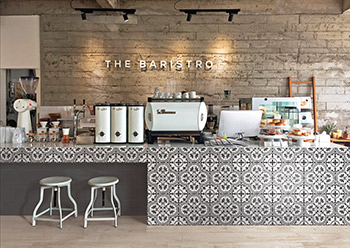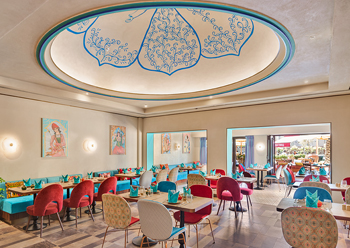
 Mezza House... a wow-factor is the custom-made flower-shaped pendant lights in two different sizes from dull gold aluminium sheets.
Mezza House... a wow-factor is the custom-made flower-shaped pendant lights in two different sizes from dull gold aluminium sheets.
The Yarmouk River Valley, a small but magically diverse ecosystem on the border of Syria and Jordan, was the main source of inspiration behind the contemporary overhaul of the iconic Dubai restaurant Mezza House, says Roar, the interior design studio responsible for giving the restaurant a new look.
Reminiscent of Mezza House’s cuisine that seamlessly fuses the different Levantine cultures, the interiors of the 290-sq-m restaurant conceived by Roar reflect the wealth of subtle but important influences of the region.
Pallavi Dean, founder and creative director of Roar, comments: “I have been a fan of Mezza House since it opened in the early 2000s. We wanted our design narrative to tell the original story of this iconic Downtown restaurant and retain its legacy, yet reimagine it for the next decade.”
Roar kept revisiting the Yarmouk River Valley during the concept development. “This is where Jordan meets Syria, where the lush riverbed rises up to meet the jagged mountains, and where summer meets winter,” Dean continues. “It is also a designer’s dream: the landscape offers an incredible array of textures and colours as inspiration. Our client wanted to redefine what a contemporary Levantine restaurant should look and feel like in Dubai today so we thought the Yarmouk River Valley, with its vast diversity, has the perfect connotations.”
 |
|
The floralscape from the Levantine region is brought in the form of wild flower bouquets. |
The restaurant is organised as a succession of naturally flowing areas rather than one open-planned space. A key part of the redesign is the labyrinthine network of golden pipes that runs across the restaurant, visually structuring the different areas and mapping out the guests’ journey.
Gold piping has been used throughout the restaurant to visually structure the space and create a delicate yet striking focal point. “The gold piping became an obvious choice as it composes a subtle architecture without imposing too much on the space. I like the way the pipes draw arch-like compositions across the walls and through the ceiling as though forming a sheltering, peaceful environment for the guests,” she explains.
 |
|
The golden pipes draw arch-like compositions across the walls and through the ceiling as though forming a sheltering, peaceful environment for the guests. |
A key element of Roar’s work is to bring the natural world indoors. As an early advocate of biophilic design, the studio has applied its principles throughout, from the rattan furniture and wall coverings to the striking floral arrangements suspended from the walls and ceiling.
“At Roar, we have always been great believers in biophilia – recreating the natural, outdoor environment indoors is paramount in many of our projects. Biophilic design can take different forms – for example, through the use of plants and natural materials such as wood and water or through biomimicry, a practice which champions nature as the greatest inspiration to design. Light is also a key element to biophilia – using the right type of light to illuminate a space allows to create different emotions: calming or invigorating, depending on what is called for. We have employed every tool in the book to bring the outdoors in with this project,” Dean says.
The idea was to bring the floralscape from the Levantine regions in the form of large wild flower bouquets suspended from the ceiling. Roar also played carefully with the scale so it balanced the abundance hanging above with delicate plaster relief work on the walls.
 |
|
The 290-sq-m Mezza House reflects the wealth of subtle but important influences of the Yarmouk River Valley. |
A soft colour palette of rose and green hues was chosen for Mezza House. The pink tones evoke the Anatolian Orchid that thrives by the Yarmouk River, while the green notes are inspired by the leaves of the emblematic Atlantic Pistachio Tree that is found in the valley.
Pallavi elaborates: “Ombre or colour gradation is present throughout, once again a theme we have borrowed from nature. If you stand at the bottom of the Yarmouk River Valley and look around your feet, you can see the vibrant colours of the grass, the plants and the shrubs. As you gradually raise your eyes to the skies, the palette changes to the more neutral grey and beige rocks at the top of the mountains. The textures also shift from soft, smooth and round to rough, jagged and angular. We deliberately incorporated these contrasts all around Mezza House, from the back of the seats to the art on the wall.”
The wall relief represents a black Iris – these are rare, resilient flowers which grow in the Middle East especially in Jordan, around the Dead Sea, the Jordan River, and the Ajloun Mountains, at the edges of the desert.
All the joinery is bespoke and Roar used American hardwood to design the furniture pieces. Simple track lights are integrated between the pipe geometry because flexibility and functionality are important considerations in a working restaurant.
“We then added the wow-factor with custom-made flower-shaped pendant lights in two different sizes from dull gold aluminium sheets,” she adds.
The flooring was made with the existing terrazzo tiles that the studio salvaged when it first started the work on-site; polished plaster has been used to create the wall relief; the bespoke booths and banquettes have been produced with American hardwood and anodised dull gold aluminium was chosen for the pipes; the chairs are from Rattan House in Dubai and the gradient effect on the booths’ backrests was created with Kvadrat fabrics.
Commenting on some of the challenges during renovation, Dean says: “Reusing the existing floor was by far the biggest challenge. The restaurant has been around for almost 10 years, so we inherited a building that featured many extensions added over the years and with them four different floor finishes. Our design response was to give visual cues of the different functions and zones of the restaurant through the flooring type. We stripped off all the layers of the flooring to unveil that which was beneath; we retained some of the terrazzo tiles for the main dining area and some of the brick pavers from the outdoor patio for the shisha (smoking) zone.”
This, in turn, presented a second challenge: to determine how to separate these two sections of the restaurant and cleverly cordon off the shisha zone from the rest of the venue, which is mainly occupied by families, while maintaining a sense of unity within the space.
“The solution we found was to divide the two areas with glass windows and place mirrors on some of the remaining walls so that the space doesn’t feel confined. This subtle division allows non-smoking and smoking guests to dine adjacent to each other,” Dean explains.
The view was also a key element Roar wished to integrate in its design. The restaurant overlooks Downtown Dubai with a stunning view of Burj Khalifa.
“We wanted the maximum of guests to enjoy this spectacular view. With that in mind, we decided to orient the tables by the windows wherever possible and use reflective rolled aluminium in other more remote areas of the venue so the view could be appreciated by everyone, almost diffused through the space,” she concludes.





















_0001.jpg)


.jpg)
















.jpg)








.jpg)



